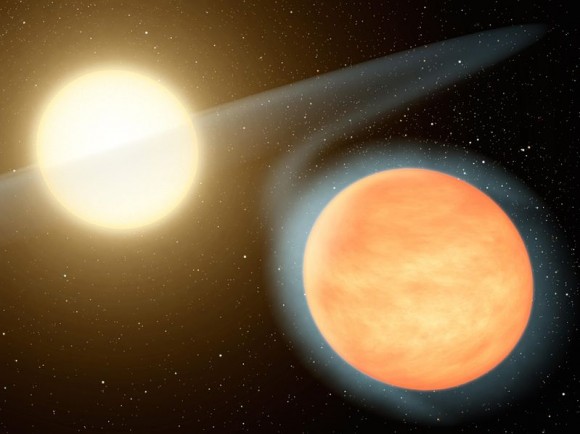New observations of one of the galaxy's hottest planets, WASP 12-b, show that it produces a magnetic field strong enough to repel most of the solar wind and turn it into a shock wave.

New observations of one of the hottest planets in the galaxy, WASP 12-b, show that it produces a magnetic field strong enough to repel most of the solar wind and turn it into a shock wave.
Like the planets themselves, the discovery of a magnetosphere outside the solar system is no surprise. It would actually be surprising if a gaseous planet the size of Jupiter or larger would not have a magnetic field, since the gas giants in our backyard have exceptionally strong magnetospheres. However, assuming that the data for this finding will remain valid, this is the first time that the phenomenon has also been proven, even if it is a confirmation of what everyone suspected until now.
WASP 12 is a yellow G-type sun similar to our sun and is 870 light-years away from Earth. The planet WASP 12-b orbits it at a distance of only 3.4 million kilometers in a record period of 26 hours. Compared, for example, to the orbit of the twinkling planet Mercury, which lasts 88 days and is 46 million kilometers from the sun.
It is of course not in the habitable zone, but the gas giant is one of the largest among them, crossing a vast field of the solar wind consisting of ionized particles, which makes it ideal for searching the magnetosphere.
The shock wave was initially detected in the dimming of the star's ultraviolet light output that preceded a complementary dip provided by the transit of the planet itself. Given the high speed of the planet's rotation some shock waves can be measured regardless of whether the planet itself has a strong magnetic field. However, in the end the data from WASP 12-b fit a model that shows that the shock wave is produced by a magnetic field and not only due to the dynamics of physics.
The findings are based on data from the SuperWASP (Wide Angle Search for Planets) project as well as the Hubble Space Telescope team, led by Dr. Aline Viduto from the University of St. Andrews. "The location of the shock wave provides us with new tools to measure the strength of the magnetic field of the planets outside the solar system. This is something that cannot be done in any other way."
Although WASP 12b's magnetic field may extend its life by shielding it from the solar wind—which would otherwise vaporize its outer layers—WASP 12b is still subject to a death sentence due to the gravitational effects of the nearby star, which is already pulling material away from the planet. The final consumption of WASP 12b is expected to be completed in about 10 million years.
WASP 12-b is not only the warmest Jupiter discovered yet, but also one of the hottest (although this may be due to expansion due to warming). But there is still one big puzzle, which cannot be solved from such a distance. Assuming that the planet is close to its sun and therefore almost certainly gravitationally fixed, it will not rotate around an axis, which mainly produces the strong magnetic field in many planets - at least those in the solar system. Maybe we need more Super Wasps to continue the investigation.
For the news in Universe Today
For the 2011 RAS National Astronomy Conference Press Release
